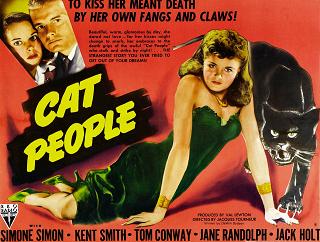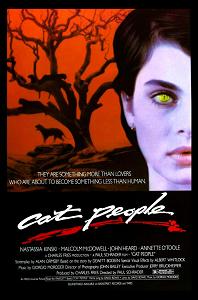Every so often, Hollywood's ceaseless remake grinder accidentally turns out an incarnation which is both a hilariously dated product of its time and a film actually in conversation with its predecessor. In this case, the predecessor is Jacques Tourner's subtle and sinister Cat People, released in 1942, which explored an othered and supernaturalized psychopathy of sexual desire in women. Paul Schrader's 1982 adaptation couldn't be less subtle (an excess of skin, the general misfortune of it being 1982), but somewhere behind the David Bowie theme song is a film still asking the same crucial questions as its parent, and coming to telling conclusions.

The first Cat People stars Simone Simon as Irena Dubrovna, a mysterious designer who begins a relationship with Oliver Reed, a couldn't-be-blander gentleman. After she reveals to him some suspiciously exoticized Serbian leopard lore that warns of women whose arousal turns them to leopards, Oliver (who never met a red flag he couldn't ignore) proposes to Irena. However, when she's reluctant to consummate the marriage, he sends her to a therapist to banish her superstitions. Irena soon discovers that while she's with Dr. Judd, her husband is becoming closer to his secretary, Alice.
Though he's the ostensible cause of all this sensual consternation, Oliver plays a notably passive part. He is both the object of and the impediment to Irena's expression of sexuality, but the position is just that—object. It's Dr. Judd who actively attempts to probe Irena's fears (and is the focus of one of Irena's later attacks). And more so, Irena's real focus turns to another character entirely.
Alice, sweet and without any active sensuality, becomes the film's designated stalkee. The spectre of infidelity is the textual reason given to Irena's fixation on her. However, the actual nature of the obsession that develops—following Alice through an abandoned park, stalking Alice as she takes an evening swim—is unmistakably pursuit, and the sexualized context is hard to ignore. Even in its horror aspects (Irena tears Alice's robe to shreds in the locker room), there is notable intimacy, though it's never textually acknowledged (the Hays Code forbade explicit expressions of homosexuality). Perhaps it was enough simply to present a text that explicitly classed sexual desire in a woman as a dangerous, transformative, and ruinous force, without having to discuss the suitability of one target over another.
And whatever the object, the outcome is the same; in order to free herself from the impossible struggle of her sexual self-expression, Irena enters the panther's cage and lets herself be torn to pieces. This conscious acknowledgment of Irena as both the victim of circumstance and the agent of her fate, combined with the light touch as regards the horror (more shadows than scratches, more dread than blood), steers the film away from a straightforward monster mash to a stylish psychological drama, a sexual noir that presents a central figure whose transformation is involuntary, fatal, and inevitable; Irena's predation is grounded in the pathos of her self-awareness, in a tragic (and tragically human) portrait.

Such self-awareness does not plague the 1982 remake, which starred Nastassja Kinski in a take on the story that highlighted the mechanics and the mythic undertones (for better, for worse, and for mangled messages). The attempts to illuminate the origin story of cat people themselves, in the sort of amusingly melodramatic (and racially eyebrow-raising) human-sacrifice prologue that succeeds only in positing questions about the feasibility of interspecies DNA exchange, and populates its canon with shape-shifters with more murderous, more complicated, and more awkward sexual boundaries.
This is, in some ways, to be expected; in the forty years since the original, the cultural conversation around women's sexuality had shifted, and the idea of a woman expressing desire was less exceptional (even lesbianism had begun to enter the mainstream). A new taboo was necessary to illustrate the psychosexual pitfalls of its central Irena. Enter Paul, her long-lost brother, with whom she's intensely reunited. She soon finds out why; Paul explains that they're both cat people, doomed to turn when aroused, unless they can find another of their own kind. Since their kind are so rare, the most usual permutation is through sibling incest—of which they themselves are a product. His sexual experiences, he says, have all ended in murder, as hers are destined to, unless they take one another as partners.
Though springing from the same central challenge to the heroine's sexuality, this new taboo is a dramatic departure, and the tensions surrounding it become the film's most significant conflict. Irena's horrified; she rejects the concept violently, turning instead to zookeeper Oliver (just as much a nonentity forty years on) as a partner. Only after Paul attacks Oliver and is killed, and Irena's feelings for Oliver intensify, does she realize Paul was telling the truth, and that her relationship with Oliver is now doomed to transform her against her will. After consummating her relationship with Oliver, she becomes the leopard, as Paul had warned. Though she flees before harming him, she recognizes the inevitable slip of control that will one day happen, and allows Oliver to bind her, have sex with her, and then keep her forever in her panther form at the zoo while he gets together with Alice, making this one of the few films in which incest with your unbalanced shape-shifting sibling is somehow the healthier of two relationship options.
Some of the complications here are simply awkward worldbuilding aftereffects. (The leopards' murderous loophole is half an excuse for lengthy body horror and half an excuse to show Malcolm McDowell with a series of topless day players; at some point, off-camera, Oliver had to explain how he spread-eagled a wild leopard on his bed.) However, it's well worth noting that even such a drastic update of the source material leaves Irena as bewildered and trapped by her sexuality as the original; even the provision of Paul as a viable sexual outlet is a genetic predestination that effectively robs Irena of choice.
Though the executions and nuances of each film are grounded in their contemporary cultural conversations, each iteration of Cat People has its focus firmly on a woman's sexual self-expression, with a remarkably cynical and sympathetic lens. Though there are obvious differences both in style and in subtext, some parallels remain strikingly intact. Women who attempt to assert sexuality are literal monsters; their sensual experiences are othered and framed by taboo; the strangers who claim them as sisters are lonely, prophetic ciphers; the men who are drawn to them inevitably retreat to the safety of secretaries and pigtailed coworkers who pine and wait. And it's more than a little telling that, though the two films are nearly half a century separated, the conclusions are also similar—to desire is to lose yourself utterly, one way or another. In fact, despite their very different executions, they function as a diptych tragedy that purports to examine two monsters, and in execution, condemns everything but its cat people.
